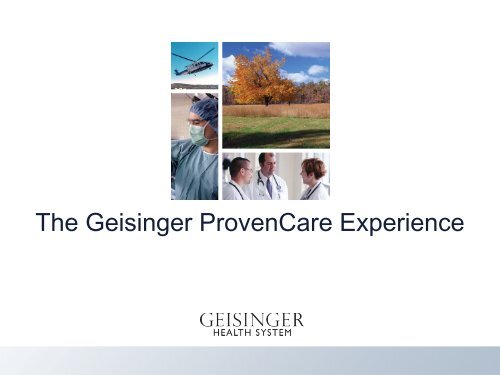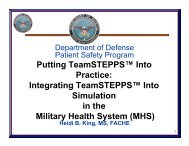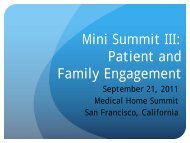The Geisinger ProvenCare Experience
The Geisinger ProvenCare Experience
The Geisinger ProvenCare Experience
You also want an ePaper? Increase the reach of your titles
YUMPU automatically turns print PDFs into web optimized ePapers that Google loves.
<strong>The</strong> <strong>Geisinger</strong> <strong>ProvenCare</strong> <strong>Experience</strong><br />
Heal • Teach • Discover • Serve
Heal • Teach • Discover • Serve<br />
A strong business case for quality<br />
• Not all appropriate care is rendered<br />
• Unnecessary care is being provided<br />
• Compliance with evidence-based guidelines known to<br />
improve outcomes is poor<br />
• Outcomes of care vary widely<br />
Division of Clinical Effectiveness
Heal • Teach • Discover • Serve<br />
<strong>ProvenCare</strong> ®<br />
• Concept: Link evidence-based practices to a<br />
continuum of care in a subclass of patients and<br />
reliably give that care to each and every patient<br />
• Purpose: Fully optimize patient outcomes<br />
Reduce unnecessary variability in care<br />
Create an idealized flow for providers<br />
and patients
Evidence<br />
• Evidence-based practices are Class I and Class IIa<br />
recommendations published by the sub-specialty’s<br />
national governing body<br />
• Physician consensus-based practices are guided by the<br />
sub-specialty’s national governing body<br />
• Applicable regulatory requirements are incorporated into<br />
best practices<br />
Heal • Teach • Discover • Serve
<strong>ProvenCare</strong> ®<br />
Heal • Teach • Discover • Serve<br />
Elective CABG<br />
Elective Cataract Surgery<br />
Elective Total Hip Replacement<br />
Elective PCI (Percutaneous Coronary<br />
Intervention)<br />
Bariatric Surgery<br />
Low Back<br />
Perinatal
Why? Because typical care has…<br />
• Clinical<br />
– Uncertain appropriateness<br />
– Variable compliance with known-to-be beneficial<br />
evidence-based best practice<br />
– Limited patient engagement<br />
– Variable outcomes<br />
• Business<br />
– Lack of accountability for outcomes and quality<br />
– A la carte payment for services<br />
– Perverse incentives: more payment for complications<br />
Heal • Teach • Discover • Serve
<strong>ProvenCare</strong> CAB and PCI<br />
% patients<br />
receiving all<br />
<strong>ProvenCare</strong><br />
components<br />
% of patients<br />
receiving all<br />
components of<br />
<strong>ProvenCare</strong><br />
100%<br />
90%<br />
80%<br />
70%<br />
60%<br />
50%<br />
40%<br />
30%<br />
20%<br />
10%<br />
0%<br />
Feb-06<br />
Apr-06<br />
100%<br />
90%<br />
80%<br />
70%<br />
60%<br />
50%<br />
40%<br />
30%<br />
20%<br />
10%<br />
0%<br />
Jun-06<br />
<strong>ProvenCare</strong> CABG<br />
Aug-06<br />
Oct-06<br />
Dec-06<br />
Feb-07<br />
Apr-07<br />
Heal • Teach • Discover • Serve<br />
Jun-07<br />
<strong>ProvenCare</strong> Elective PCI<br />
Oct-07<br />
Nov-07<br />
Dec-07<br />
Aug-07<br />
Oct-07<br />
Dec-07<br />
Feb-08<br />
Apr-08<br />
Jun-08<br />
Aug-08<br />
Oct-08<br />
Dec-08<br />
Feb-09<br />
Apr-09<br />
Jun-09<br />
Aug-09<br />
Jan-08<br />
Feb-08<br />
Mar-08<br />
Apr-08<br />
May-08<br />
Jun-08<br />
Jul-08<br />
Aug-08<br />
Sep-08<br />
Oct-08<br />
Nov-08<br />
Dec-08<br />
Jan-09<br />
Feb-09<br />
Mar-09<br />
Apr-09<br />
May-09<br />
Jun-09<br />
Jul-09<br />
<strong>ProvenCare</strong> CABG<br />
Snapshot:<br />
-5 Surgeons<br />
-2 hospitals<br />
<strong>ProvenCare</strong> patients through Aug 2009<br />
393<br />
<strong>ProvenCare</strong> PCI<br />
Snapshot:<br />
- 6 Interventionalists<br />
-2 Hospitals<br />
<strong>ProvenCare</strong> patients through July 2009<br />
945
<strong>ProvenCare</strong> Cataract and Total Hip Replacement<br />
% of patients<br />
receiving ALL<br />
<strong>ProvenCare</strong><br />
components<br />
% patie nts<br />
receiving all<br />
<strong>ProvenCare</strong><br />
components<br />
100%<br />
90%<br />
80%<br />
70%<br />
60%<br />
50%<br />
40%<br />
30%<br />
20%<br />
10%<br />
0%<br />
100%<br />
90%<br />
80%<br />
70%<br />
60%<br />
50%<br />
40%<br />
30%<br />
20%<br />
10%<br />
0%<br />
Mar-07<br />
May-07<br />
<strong>ProvenCare</strong> Total Hip Replacement: GMC and GWV<br />
Mar-07<br />
May-07<br />
Jul-07<br />
Sep-07<br />
<strong>ProvenCare</strong> Cataract<br />
Nov-07<br />
Jan-08<br />
Mar-08<br />
Heal • Teach • Discover • Serve<br />
May-08<br />
Jul-08<br />
Sep-08<br />
Nov-08<br />
Jan-09<br />
Mar-09<br />
May-09<br />
Jul-09<br />
Jul-07<br />
Sep-07<br />
Nov-07<br />
Jan-08<br />
Mar-08<br />
May-08<br />
Jul-08<br />
Sep-08<br />
Nov-08<br />
Jan-09<br />
Mar-09<br />
May-09<br />
Jul-09<br />
<strong>ProvenCare</strong> Cataract<br />
Snapshot:<br />
- 9 Surgeons<br />
- 4 Hospitals (2 non-<strong>Geisinger</strong>)<br />
- 2 Surgical Centers<br />
<strong>ProvenCare</strong> patients through July 2009<br />
4022<br />
<strong>ProvenCare</strong> THR<br />
Snapshot:<br />
- 6 Surgeons<br />
-2 Hospitals<br />
<strong>ProvenCare</strong> patients<br />
through July 2009<br />
871
<strong>ProvenCare</strong> Bariatric<br />
% of patients<br />
receiving all<br />
components<br />
of care<br />
100%<br />
80%<br />
60%<br />
40%<br />
20%<br />
0%<br />
Snap Shot:<br />
Heal • Teach • Discover • Serve<br />
Bariatric Surgery <strong>ProvenCare</strong>®<br />
May-08<br />
Jun-08<br />
Jul-08<br />
Aug-08<br />
Sep-08<br />
Oct-08<br />
Nov-08<br />
Dec-08<br />
Jan-09<br />
Feb-09<br />
Mar-09<br />
Apr-09<br />
May-09<br />
Jun-09<br />
Jul-09<br />
Months<br />
Patient population: ~800 in the program, 400 proceed to surgery each year<br />
Duration: Pre-surgery- 7 months<br />
Post-surgery- 12 months<br />
Surgical approaches: 2<br />
Professionals: Surgeons-5 Internal Medicine- 2<br />
Psychology-2 Nutritional Spec.-6<br />
<strong>ProvenCare</strong> patients through July 2009<br />
599
Perinatal <strong>ProvenCare</strong> ® Goals<br />
• 103 Discrete evidence-based elements of care are<br />
incorporated, measured and tracked for compliance<br />
• Redesign, from the ground up, all aspects of provider<br />
workflow<br />
– Drive fundamental efficiency improvements<br />
– Increase patient safety and process reliability<br />
– Reduce/eliminate documentation redundancy<br />
– Streamline patient education and cut costs<br />
• Seek observable reductions in C-section rates and<br />
premature births<br />
• Enhance management of comorbid conditions<br />
• Improve fetal/child health and wellness<br />
Heal • Teach • Discover • Serve
Heal • Teach • Discover • Serve<br />
Does it work?
<strong>ProvenCare</strong> ®<br />
brings national attention<br />
May 24 th , 2007 at the George Washington University Medical Center<br />
HEALTH CARE: Hillary Remarks on Reducing the Cost of Health Care<br />
Heal • Teach • Discover • Serve
Heal • Teach • Discover • Serve<br />
Lessons Learned
Total Hip Quality Manager Data Improvements with >90%<br />
compliance<br />
• Decreased LOS<br />
– 3.6% reduction<br />
• Decreased 30 day readmission rate<br />
– 58% reduction<br />
• Decreased DVT rate<br />
– 49% reduction<br />
• Decreased PE rate<br />
– 67% reduction<br />
Quality Manager Data<br />
Not statistically significant<br />
Heal • Teach • Discover • Serve
Quality Manager Data/ Not statistically significant<br />
Heal • Teach • Discover • Serve<br />
CY prior to<br />
<strong>ProvenCare</strong><br />
Expected CY 2009 % change<br />
Mortality 0.90% 0.10% 0.00%<br />
Morbidity¹ 3.50% 1.90% 1.00% 71%<br />
Complications 27.90% 27.10% 16.30% 42%<br />
LOS 3.8 2.8 2.8 26%<br />
Geometric Cost $10,057 $14,292 $12,715 26%<br />
¹Morbidity Rate, as defined by Quality Manager, is the percentage of patients who develop at least one morbid complication during hospitalization. Patients are said to have a morbid complication if the clinical impact of the<br />
complication was determined to be in the category of D or E as outlined below:<br />
Morbidity Clinical Impact<br />
A None or trivial<br />
B One or two day increase in LOS<br />
C Unscheduled ICU admission and one or two day increase in LOS<br />
D 50%+ risk of temporary impairment, unscheduled ICU admission and / or 3+ day increase in LOS<br />
E 50%+ risk of temporary impairment, unscheduled ICU admission and / or doubling LOS
4.00<br />
3.50<br />
3.00<br />
2.50<br />
2.00<br />
1.50<br />
1.00<br />
0.50<br />
0.00<br />
Heal • Teach • Discover • Serve<br />
<strong>ProvenCare</strong> Total Hip Average LOS<br />
2007 2008 2009<br />
GMC<br />
GWV<br />
combined
Quality Manager Data<br />
25%<br />
20%<br />
15%<br />
10%<br />
5%<br />
0%<br />
Heal • Teach • Discover • Serve<br />
Transfusion Rate<br />
2007 2008 2009<br />
GMC<br />
GWV
<strong>ProvenCare</strong> Perinatal<br />
Quality Measures<br />
Percent<br />
47<br />
42<br />
37<br />
32<br />
27<br />
22<br />
17<br />
12<br />
UCL=45.5<br />
Avg=29.0<br />
LCL=12.5<br />
Heal • Teach • Discover • Serve<br />
GWV Primary C-Sections Jan 2008-Dec 2009<br />
UCL=31.4<br />
Avg=21.4<br />
LCL=11.4<br />
7<br />
Implementation of electronic process<br />
2<br />
Jan-08 Feb-08 Mar-08 Apr-08 May-08 Jun-08 Jul-08 Aug-08 Sep-08 Oct-08 Nov-08 Dec-08 Jan-09 Feb-09 Mar-09 Apr-09 May-09 Jun-09 Jul-09 Aug-09 Sep-09 Oct-09 Nov-09 Dec-09
Balancing the Message- AHRQ Patient<br />
Safety Indicator 17<br />
• <strong>The</strong> numerator includes any of the following<br />
diagnosis codes: 767.0, 767.11, 767.3, 767.4, 767.5,<br />
767.7, 767.8<br />
• Subdural and cerebral hemorrhage (due to trauma or<br />
to intrapartum anoxia or hypoxia)<br />
• Epicranial subaponeurotic hemorrhage (massive)<br />
• Injuries to skeleton (excludes clavicle)<br />
• Injury to spine and spinal cord<br />
• Facial nerve injury<br />
• Other cranial and peripheral nerve injuries<br />
• Other specified birth trauma<br />
Heal • Teach • Discover • Serve
Quality Performance- AHRQ Patient<br />
Safety Indicator 17<br />
Heal • Teach • Discover • Serve<br />
# of All<br />
Diaganoses birth<br />
Numerator<br />
based on PSI 17<br />
Birth Trauma Rate<br />
based on PSI 17<br />
definition (per 1000<br />
babies)<br />
Population of Population of<br />
Number of<br />
Mothers Babies trauma cases Excluded cases definition<br />
FY2008 2635 2888 20 5 15 5.19<br />
FY2009 2786 3054 10 5 5 1.64<br />
-At GWV, there is no change in PSI 17 Birth Trauma Rates although vaginal<br />
deliveries have increased (GWV remains below the national average)<br />
-As a system, there is a significant decline in PSI 17 for FY09 (p=0,047). <strong>The</strong><br />
national average is 2.31<br />
http://www.ahrq.gov/qual/nhqr07/measurespec/patient_safety.htm#rtraumt1
Heal • Teach • Discover • Serve<br />
Length of stay<br />
• 488 Proven Care patients from May 2008 through June 2009<br />
• Length of stay was categorized into two group (2 day length of stay<br />
60%<br />
50%<br />
40%<br />
30%<br />
20%<br />
10%<br />
0%<br />
55%<br />
Cochran-Armitage Trend test p-value = 0.0002<br />
27%<br />
23%<br />
N=40 N=93<br />
N=126<br />
21%<br />
90 day Readmissions<br />
14.00%<br />
12.00%<br />
10.00%<br />
8.00%<br />
6.00%<br />
4.00%<br />
2.00%<br />
0.00%<br />
Heal • Teach • Discover • Serve<br />
FY 2008 FY 2009<br />
FY 2008: 413 cases, 51 readmissions<br />
FY 2009: 427 cases, 29 readmissions<br />
Rate
Why Were Our Outcome Not Even<br />
Better?<br />
• Only 60-70% of patients received all 42<br />
measures<br />
Heal • Teach • Discover • Serve
Why Were Our Outcome Not Even<br />
Better?<br />
• Only 60-70% of patients received all 42<br />
measures<br />
--- But most patients missed only 1 measure<br />
Heal • Teach • Discover • Serve
Why Were Our Outcome Not Even<br />
Better?<br />
• Only 60-70% of patients received all 42<br />
measures<br />
--- But most patients missed only 1 measure<br />
Heal • Teach • Discover • Serve
Why Were Our Outcome Not Even<br />
Better?<br />
• Only 60-70% of patients received all 42<br />
measures<br />
--- But most patients missed only 1 measure<br />
• Some measures increased detection of<br />
complications<br />
Heal • Teach • Discover • Serve
Why Were Our Outcome Not Even<br />
Better?<br />
• Only 60-70% of patients received all 42<br />
measures<br />
--- But most patients missed only 1 measure<br />
• Some measures increased detection of<br />
complications<br />
Heal • Teach • Discover • Serve
Why Were Our Outcome Not Even<br />
Better?<br />
• Only 60-70% of patients received all 42 measures<br />
--- But most patients missed only 1 measure<br />
• Some measures increased detection of complications<br />
– Proven PCI measures that prevent complications: 14<br />
– Proven PCI measures detect more complications: 10<br />
– ProvenPCI measures no affect on complications: 18<br />
Heal • Teach • Discover • Serve
<strong>ProvenCare</strong> should deliver more<br />
value<br />
• Approach is patient centric<br />
• Evidence-based care delivers better<br />
outcomes<br />
• Provider documents appropriateness<br />
• Enables an activated participative member<br />
Heal • Teach • Discover • Serve
Every system is perfectly designed to<br />
get the result it gets- Paul Batalden, MD<br />
Heal • Teach • Discover • Serve





